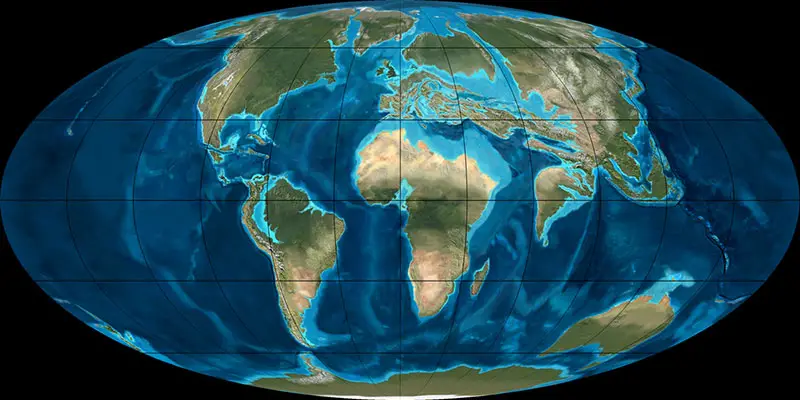†Loveina (Omomyidae)
Loveina ist eine Primatengattung innerhalb der Familie Omomyidae, deren 6 Mitglieder ab dem frühen Paläogen (Eozän) im Ypresium lebten, das vor ungefähr 56 Millionen Jahren begann und bis vor 47,8 Millionen Jahren andauerte. Viele Überreste wurden in Vereinigte Staaten von Amerika (USA) gefunden.
Loveina ist der Gattungsname dreier Primaten aus der Familie Omomyidae (Tribus Washakiini innerhalb der Unterfamilie Omomyinae), die im Eozän in Nordamerika verbreitet waren.
Die Überreste sind zwischen 55,4 und 50,3 Millionen Jahre alt.
Loveina minuta
Basierend auf der Größe und Morphologie eines unteren Backenzahns (M1) schätzt man das Körpergewicht auf 143,4 Gramm. Außerdem kann man Aussagen über die Lebensweise machen: Loveina minuta war ein baumlebender Insektenfresser. Die Funde stammen aus dem Sweetwater und Fremont County, Wyoming (Wasatch und Wind River Formation) und sind zwischen 55,4 und 50,3 Millionen Jahre alt. Sie werden teilweise wird am U.S. Geological Survey aufbewahrt.
| Sammlung | Kommentar zum Fundort | Epoche, Alter | Geologie, Formation | Kommentar zur Sammlung |
|---|---|---|---|---|
| Table Rock | Wasatch | USGS D786; UW V-58001 | ||
| Museum | Kommentar z. Taxonomie | |||
| USGS | said by Gazin to be "Tipton Tongue" of Wasatch Fm.; however, originally reported by McGrew and Roehler 1960 as Niland Tongue, and this was repeated by Roehler 1987, Roehler and Stanton 1992 and Covert and Hamrick 1991 USGS number and coordintes given by Roehler 1987, whose list is based on a 1969 Gazin pers. comm. SE 1/4 SE 1/4 NE 1/4 sec 8 T 18 N R 98 W |
| Physiologie | |
|---|---|
| Gewicht: | ? |
| Schwestertaxa | |
Loveina wapitiensis
Basierend auf der Größe und Morphologie eines unteren Backenzahns (M1) schätzt man das Körpergewicht auf 241,3 Gramm. Außerdem kann man Aussagen über die Lebensweise machen: Loveina wapitiensis war ein baumlebender Insektenfresser. Die Funde stammen aus der Willwood Formation (Park County, Wyoming) und sind zwischen 55,4 und 50,3 Millionen Jahre alt.
| Sammlung | Kommentar zum Fundort | Epoche, Alter | Geologie, Formation |
|---|---|---|---|
| North Fork of the Shoshone River (NF-1) | Willwood | ||
| Kommentar z. Stratigraphie | Kommentar z. Taxonomie | ||
| said to be Lostcabinian | stratigraphic level is unclear; Torres 1985 places it at 80 meters, but Gunnell et al. correlate it at above 100 m without giving details |
Loveina zephyri
Das Typusexemplar mit der Bezeichnung Amer. Mus. No. 32517 ist ein linker Unterkiefer mit Prämolaren und Molaren (P3-M1). Der Fund stammt aus der Wind River Formation (Fremont County, Wyoming) und ist zwischen 55,4 und 50,3 Millionen Jahre alt.
| Sammlung | Kommentar zum Fundort | Epoche, Alter | Geologie, Formation | Kommentar zur Sammlung |
|---|---|---|---|---|
| Dad | Wasatch | UCMP V-5721 | ||
| Museum | Kommentar z. Taxonomie | |||
| UCMP | placed in the Niland Tongue by Krishtalka et al. 1987 |
Literatur
G. G. Simpson 1940, Studies on the earliest primates. Bulletin of the American Museum of Natural History. 77:4, p. 185 - 212P. Robinson 1966, Fossil Mammalia of the Huerfano Formation, Eocene, of Colorado. Peabody Museum of Natural History Bulletin. 21:4, p. 1 - 95
D. A. Guthrie 1967, The mammalian fauna of the Lysite Member, Wind River Formation (early Eocene) of Wyoming. Memoirs of the Southern California Academy of Sciences. 5:4, p. 1 - 53
R. M. West 1973, Geology and mammalian paleontology of the New Fork-Big Sandy area, Sublette County, Wyoming. Fieldiana: Geology. 29:4, p. - 53
T. M. Bown 1979, New Omomyid Primates (Haplorhini, Tarsiiformes) from Middle Eocene Rocks of West-Central Hot Springs County, Wyoming. Folia Primatologica. 31:4, p. - 53
R. K. Stucky 1984, Revision of the Wind River faunas, early Eocene of central Wyoming. Part 5. Geology and biostratigraphy of the upper part of the Wind River Formation, northeastern Wind River Basin. Annals of Carnegie Museum. 53:9, p. 231 - 294
G. F. Gunnell, W. S. Bartels, P. D. Ginberich, V. Torres 1992, Wapiti Valley Faunas: Early and Middle Eocene Fossil Vertebrates from the North Fork of the Shoshone River, Park County, Wyoming. Contributions from the Museum of Paleontology, University of Michigan. 28:11, p. 247 - 287
H. H. Covert, M. W. Hamrick, P. D. Ginberich, V. Torres 1993, Description of new skeletal remains of the early Eocene anaptomorphine primate Absarokius (Omomyidae) and a discussion about its adaptive profile. Journal of Human Evolution. 25:11, p. - 287
J. Alroy, M. W. Hamrick, P. D. Ginberich, V. Torres 2002, Synonymies and reidentifications of North American fossil mammals. . :11, p. - 287
P. A. Holroyd, S. G. Strait, P. D. Ginberich, V. Torres 2008, New data on Loveina (Primates: Omomyidae) from the early Eocene Wasatch Formation and implications for washakiin relationships. Elwyn Simons: A Search for Origins. :11, p. 243 - 257
